HUMAN EYES AND COLOURFUL WORLDS for Class 10 PHYSICS
THE HUMAN EYE
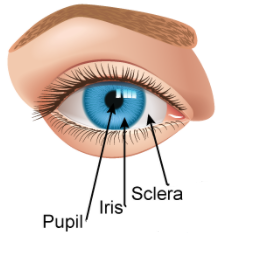
Kya aapne kabhi kisi aise video camera ke bare me suna hai jiska resolusion 576 MP hota hai. Ye auto focus hota hai or image ko stablize karke bhi rakhta hai. Yah bright light or low light dono hi condition me achche se work karta hai. Iska sbse best part hai ki hume ise charge bhi nahi karna padta. To kya aap jante hai ki hum yaha pr kis video camera ki baat kr rahe hai? Its the human eye. Hum yaha pr human eye kaise work karta hai or iske different parts ke bare me discuss karenge.
Hamari aankhon ke front position se start karte hai.
Sclera - Jab hum kisi ki aankhon me dekhte hai to hume jo dikhta hai wo hai eyes ka white portion jise sclera kahta hai. Ye eyes ke protective layer ka kam karta hai.
Cornea - Center me jo circular part hota hai wo transparent layer hota hai jise hum cornea kahte hai.
Iris - Coloured portion iris kahlata hai jo ki aankhon me enter karne wale light ko control karta hai.
Pupil - Eyes ke center portion pupil kehlata hai jisse light ankhon me enter karta hai.
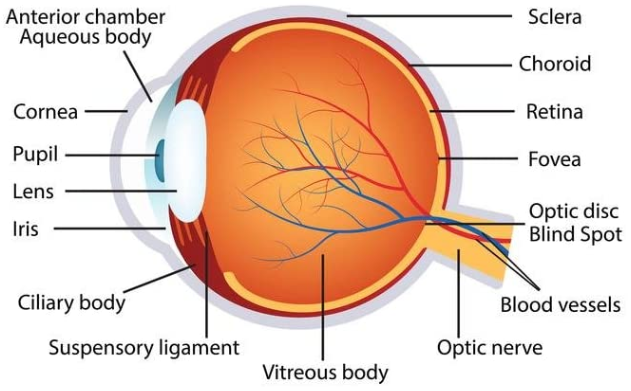
Eyes ke inside me ager hum side view dekhe to uper diye gaye figure me dikhaya gaya hai. Aap dekh sakte hai ki eyes shape me spherical jaisa hota hai. Isliye hum ise eye ball kahate hai. Eyes ka approx diameter 25 mm hota hai. Jaisa ki humne eyes ka front layer dekha jise cornea kahate hai. Cornea bahar ki taraf nikla hua hota hai, or transparent hota hai. Isliye light aankho me enter karta hai. Cornea ka function light rays ko refract karna hota hai jo ki eyes me image form karne me help karta hai.
Aap yaha pr dekh skte hai ki light air se cornea me enter karta hai. Air ka refractive index 1 hota hai or cornea ka refractive index 1.376 hota hai. Isliye light yaha pr rarer to denser medium me enter kr raha hai or cornea me light bend ho raha hai. Iske alawa cornea ka function eyes ko protect karna hota hai.
Kya aap jante hai ki different logo ki aankhon ka colour different kyu hota hai? Ye eyes ke next part iris ke karan hota hai. Iris ka colour eyes me present amount of melanin ke uper depend karta hai. Iris flate, coloured or ring shaped membrane hota hai joki cornea ke pichhe hota hai.
Iris ke bich me pupil hota hai jisse light aankhon me enter karta hai. Iris ka function eyes me enter karne wale light ko control karta hai. Light ko control karne ke liye pupil ke size ko adjust karta hai. Jab light bright hota hai to iris pupil ka size decrease kr deta hai jisse less amount me light eyes me enter karta hai taki hum proper dekh sake. Ager dark place ho jaise ki movie theater tb iris pupil ka size increase kr deta hai taki jyada light eyes me enter kr sake or hum better dekh sake. Aapne notice kiya hoga ki jab aap bright light se dark room me enter krte hai to kuchh time tk apko kuchh thk se dikhai nahi deta kyuki iris pupil ko adjust karne me thoda time leta hai.
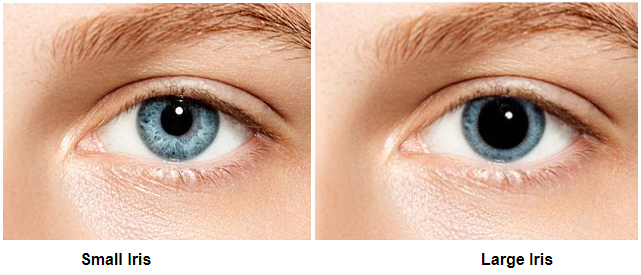
Aqueous humour - Cornea or eye lens ke bich jo liquid hota hai wah aqueous humour kehlata hai. Jiska function eyes ke ander fluid presser ko maintain karna hota hai. Ye pressure eyes ball ke walls ko tight rakhne me help karta hai or roughly spherical shape maintain karta hai. Ye nutrition bhi provide karta hai example ke liye amino acids or glucose eyes ke sare parts jaise ki cornea and eye lens.
Eyes lens - Eye lens transparent soft or flexible hota hai. Kya aap jante hai ki hamare eyes ka lens ek living things hai jo ki cells se bna hota hia. Human eye me convex type ka lens hota hai. Jaisa ki aap dekh skte hai figure me ki center se lens thick hota hai jbki edges se thin hota hai. Convex lens me converging action hota hai. Eye lens ka kam light rays ko refract karna hota hai jiska clear image retina pr banta hai. Convex lens ka refractive index approx 1.4 hota hai. Convex lens flexible hota hai ye apni shape or thickness ko change kr skta hai. Isliye ye apni focal length ko adjust kr skta hai joki different distance pe rakhe object ko focus kr skta hai or hume humari retina pr clear image milta hai. Eye lens ka yeh adjustment power of accommodation kehlata hai jiske bare me hum aaghe baat karenge.
Suspensory ligament - Eyes lens apne position me suspensory ligament ki help se hota hai. Suspensory ligament ka ek end eye lens se or dusra end ciliary muscles se connect hota hai.
Ciliary muscles - Jaisa ki fig me dikhaya gaya hai ciliary muscles eyes lens ka thickness ko change karti hai taki eye lens light rays ko retina pr focus kr sake. Ye eyes ka power of accommodation kehlata hai.
Vitreous humour - Eyes ke pichhe ka space vitreous chamber kehlata hai. Jo ki fluid ko contain krke rakhta hai jise hum virerous humour kahlata hai.
Vitreous humour ka function lens ko support karna or eyes ball ka shape ko maintain karna hota hai. Vitrerous humour 99% water hota hai jisse light isse bina deflect hue pass ho pata hai. Yaha pr fluid liquid lens ke jaisa act krta hai or aage light rays ko retina pr focus karne me help karta hai.
Retina - Eyes ke back part me screen hoti hai jaha images form hoti hai. Ye screen retina kehlata hai.
Retina ek film ke jaisa hota joki phle ke cameras me hota tha or aaj ke digital cameras me digital sesor ke jaisa hota hai.
Rods or Cones - Retina large numbers of sensitive cells ko contain karke rakhta hai joki rods or cones kehlata hai.
Rod cell light ki intensity ke liye bht sensitive hota hai jiske karan hume roshni or andhere ka difference pta chalta hai. Iske karan object ke colours ko bhi hum pehchan pate hai.
Ager hum kisi room ki light ko km kr de to kya aap waha present kisi object ka colour bta skte hai? Nahi kyuki jo cone cell hai use object ke colour ko pehchanne ke liye proper light ki jarurt hoti hai. Pr yaha pr rod cell work kr ra hai ki is room me koi object rakha hua ai. Jb hum lights on kr dete hai, tb hum us room me rakhe object ke colours ko easily phchan skte hai. Iska mtlb hai ki rod cell light or dark ka information deta hai or cone cell object ke colours ko pehchan pata hai.
Aap ise easily yaad rakh sakte hai c for cone c for colour
Optic nerves - Eyes ball ke last me ek nerve hoti jise optic nerve kahte hai joi retina se attach hoti hai. Optic nerves sare visual information ko retina se brain me transfer karta hai jiske karan hum apne charo taraf ki duniya ko dekh pate hai. Eyes ek camera ki tarah behave karti hai or brain hume vision deta hai.
Blind spot - Optic nerves me jis point pr retina se milti hai us point pr koi bhi light sensitive cell nahi paya jata jiska mtlb hai ki us point pr koi bhi rod ya cone cells nahi hota is point ko blind spot kahate hai. Is point pr koi vision nahi milta. Ager light ray is point pr padti hai to koi bhi image nahi bnti. Retina pr jo image banti hai wo real or inverted image banti hai or bht hi chhoti image hoti hai.
Jaisa ki hum jante hai real images inverted hoti hai pr jb ye images brain tk phuchti hai to brain in images ko sidha karke dikhati hai jisse hume chije sidhi hi dikhai deti hai.
Human eyes ke sare parts ek sath kaise work karte hai ise smjhne ke liye hum human eyes ki working dekhenge.
Working - Human eyes ki working ko smjhne ke liye hum ise kisi camera se compare karenge. Jab hum cameras use karte hai to sbse phle hum lens cap ko remove karte hai. Isi tarah hume apne eyes ko open karne ki jarurt hoti hai. Iske baad hume camera ke aperture ko set karna hota hai ager camera ka aperture bht chhota ho to image dark banti hai.
Ager aperture bht badha hota hai to light bht bright hota hai. Isi tarah jb hum eyes open krte hai to pupil ka size eyes me enter karne wale light ke amount ko determine karta hai. Iris pupil ke size ko control karta hai.
Next hume camera me focusing ring ko ghuma ke object ke focus ko control karte hai kyuki jb hum camera ke focus ko adjust karte hai to hume clear picture milta hai. Ager hum focus ko adjust nahi karenge to hume picture blurred milega. Human eyes me auto focus hota hai joki pupil ke size ko adjust karke light rays ko retina pr focus karta hai or retina pr clear image banta hai. Eyes me focus ko adjust karne ke liye lens ka shape or thickness bhi adjust hota hai.
Power of Accommodation
Humne eye lens ke baare me baat kiya joki jelly jaise material se bna hota hai or apna size and shape, cilliary muscles ke help se change kr skta hai. Jiske karan eye lens ki focal length bhi change ho sakti hai. Jab ciliary muscles relaxed hota hai tb lens thin hoti hai or focal length increase hota hai hai. Iske just opposite jb hum eyes ko kabhi stress dete hai jaise ki ager maan lo ki hume koi object blur dikh ra ho tb eye lens thick hone ke karan focal length decrease ho jata hai or hume blur object clear dikhai de pata hai.- Eye lens ke dwara focal length ko adjust karne ki ability ko hi power of accommodation kahte hai.
Eye lens of focal length ek limit tk hi increase or decrease hote hai.
Normal eyes ke liye power of accommodation 25 cm hota hai. Isiliye jab kisi notebook ko bht pass se padhne pr wo blur dikhai dete hai or eyes me stress feel hota hai tb use proper distance pe rakh ke padha jata hai. Eyes ko bina stress diye clear image dekhne ke liye minimum distance 25 cm hai jise eyes ka near point kahte hai. Jitni dur tk hum dekh pate hai use eyes ka far point kahate hai.
Old age me eyes ke lens milky or cloudy ho jate hai is condition ko cataract kahte hai. Iske karen partial ya complete vision chala jata hai jise cataract surgery se vision ko restore kiya jata hai.
You know... Why do we have two eyes instead of one eye ? Two eyes are better than one eye because
The field of view with two eyes is more than with one eye.
two eyes give a three dimensional picture of an object (i.e., the length, breadth and depth or height of an object) whereas one eye gives only a two dimensional picture of an object.
POINT 1
1. Definition of Power of Accomodation -The ability of the eye lens to adjust its focal length, so as to clearly focus rays coming from distant as well a near object on the retina, is called the power of accommodation of the eye.
EXAMPLE 1
(a) Name the following part of the human eye : A thin membrane through which light enters the eye.
(b) Write the function of iris in the human eye.
Or
Mention the name of a structure formed in the human eye that controls the size of the pupil.
(c)What is the function of pupils in the human eye ? (CBSE 2011, 2012)
(d) Name the following part of the human eye : A dark muscular diaphragm that controls the size of the pupil.
(a)Cornea.
(b) Iris controls the size of the pupil.
(c) It controls and regulates the light entering the eye.
(d) Iris
EXAMPLE 2
What is meant by accommodation of the human eye ? How is it achieved ?
Accommodation or power of accommodation of the human eye is the ability of the eye to observe distinctly the objects situated at widely different distances from the eye.
This property is due to the action of ciliary muscles holding the eye lens.
For observing distant objects, the eye is in a relaxed state, i.e., unaccommodated. The eye lens is thin and an image of a distant object is formed on the retina.
For observing nearby objects, the ciliary muscles contract, the eye is in a state of tension. It is said to be accommodated.
EXAMPLE 3
What is meant by range of vision ? What is its value for a person with normal vision ?
The range of vision of a person is the distance between near point (N) and far point (F) of his eyes. The point at closest distance, at which an object can be seen clearly by the eye is called near point (N) of the eye.
The most distant point at which an object can be seen clearly is called far point (F) of the eye. For a normal eye, far point lies at infinity. Therefore, for a person with normal vision, the range of vision is infinite.
DEFECTS OF VISION AND THEIR CORRECTION
Jab kisi person ka eye power gradually loose kare ya kahe ki power of accommodation ko tab person ko kisi bhi object ko clear dekhne mai difficulty hogi. Isi eye defect kehte hai.
Eye defect ke three types hote hai hai aur wo hai :
- Myopia
- Hypermetropia
- Presbyopia
1. Myopia : Myopia ko short sightedness or near sightedness bhi kehte hai. Is defect me person :
- Pass ke objects ko clearly dekh pata hai.
- Aur door ke objects clear nahi dekh pata.
Is liye ise kehte hai near-sightedness. Door ki objects ko clear dekhne ke liye myopic person ko spectacles ki zaroorat hoti hai.
For example: A myopic person ko book read karne me koi taklif nahi hogi per wahi person jab class ke back me baitha ho aur board me likhiy writing ko wo clearly nahi dekh payega use woh writing blurry or hazy nazar ayega.
- myopic person ko right power ke spects ka use karna hoga far objects ko clear dekhne ke liye.
- Jayda tar school students jo spects use karte hai unhe moyopic defect hota hai.
Cause & Affect:
- Is me eyeball elongated ho jata hai.
- Focal length will be shorter.
- Image will form in front of the retina.
- Jab myopic person far objects ko dekhne ki koshish karta hai toh use object ka image retina ke samne banta hai hai jiski wajah se wo image clear nahi hota.

Correction :
- a) Spects ke use se is defect ko correct kar sakte hai.
b) Spects me hum concave lens(diverging lens hai) ka use karte hai jo object ke image ko diverge kar ke retina me point karta hai jis se image clear ho jata hai.
b) Suitable power for lenses should be used in spects.
2. Hypermetropia : Is eye defect ko far sight-sightedness or long sight-sightedness bhi kahte hai. Ye defect opposite hota hai myopia ka. Is defect me :
- Pass ke objects ko clearly nahi dekh pata hai usko images blurry ya hazy nazar aate hai.
- Aur door ke objects clear hote hai.
Is liye ise kehte hai long-sightedness. Pass ki objects ko clear dekhne ke liye spectacles ki zaroorat hoti hai.
For example: Is defect me person ko book read karne me taklif hogi per wahi person jab class ke back me baitha ho aur board me likhiye writing ko clearly dekh payega use woh writing blurry or hazy nazar nahi ayega.
- Is defect person ko right power ke speects ka use karna hoga pass objects ko clear dekhne ke liye.
Cause & Affect :
- Is defect me eyeball shorten ho jate hai.
- Focal length will be longer
- Image will form behind the retina.
- Jab person book read karne ki koshish karta hai toh use book ka image retina ke back me banta hai hai jiski wajah se wo image clear nahi hota.
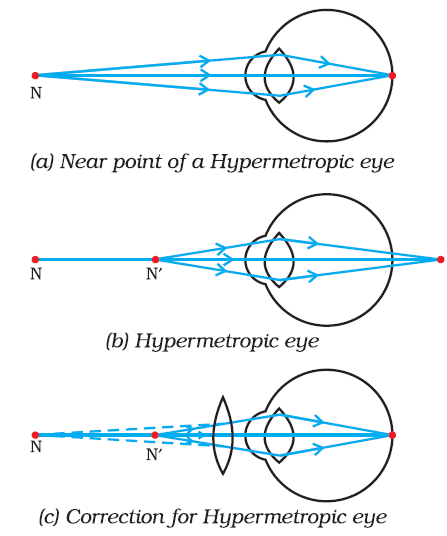
Correction :
- a) Spects ke use se is defect ko correct kar sakte hai.
b) Spects me hum convex lens(converging lens hai) ka use karte hai jo object ke image ko converge kar ke retina me reflect karta hai jis se image clear ho jata hai.
b) Suitable power for lenses should be used in spects.
3. Presbyopia : Jaise hamari age me progress hoti waise hi eye ka accomodation power kam hone lagta hai, is defect ko presbyopia kahte hai. Yeh hypermetropia hai due to age. Yeh defect 40 ki age se start hota hai aur 60 ke baad bahut speed se worse hota hai. Is defect me, jo hum spects use karte hai use reading glasses kahte hai.
Cause : It arises due to the gradual weakening of the ciliary muscles and diminishing flexibility of the eye lens.
Sometimes, a person may suffer from both myopia and hypermetropia. For such defects we use reading glasses. Such glasses contain both concave and convex lenses, the upper part of glass contains concave and the lower part contains convex. There will be a thin line between lenses.
Issue for reading glasses : Due to thin line power of glasses changes suddenly. New types of glasses are available which are called progressive lenses; they are also called multifocal lenses.
OMR (One Minute Revision)
- * Far point for normal eye is infinity and near point is 25 cm.
* Far point for myopic eye is 1m (for different people it may vary) and near point is 25 cm.
* Far point for hypermetropia is infinity and near point is 50 cm.
POINT 2
1. Myopia : - Myopia, Also Called Near sightedness, is a eye defect in which the patients are not able to see objects at long distances clearly.
2. Hypermetropia : - Is a defect of an eye where a person cannot see nearby objects clearly. This defect of eye is caused due to, non-converging power of eye-lens, eyeball being too short, in this case the image of an object is formed behind the retina and therefore, a person cannot see nearby objects.
3. Presbyopia : - Is that defect of vision due to which an old age person cannot see the nearby objects clearly due to loss of power of accommodation of the eye. In old age , the ciliary muscles becoming weak and the eye lens loses some of its elasticity and the eye loses its power of accommodation.
EXAMPLE 4
(a) A student cannot see clearly a chart hanging on a wall placed at a distance 3 m from his eye. Name the defect of vision he is suffering from. Draw a ray diagram to illustrate this defect. List its two possible causes.
(b) Draw a ray diagram to show how this defect may be corrected using a lens of appropriate focal length.
(c) An eye donation camp is being organised by social workers in your locality. How and why would you help in this cause?
(a) Myopia or Short-sightedness is the inability of an eye in viewing long distance objects. The image in this case falls before the retina. For every myopic eye, there exists a far point beyond which clear image cannot be seen. Short-sightedness is caused due to
(i) excessive curvature in cornea.
(ii) elongation of eyeball.
(b) The short-sightedness is corrected by using a concave lens which diverges and shifts the image to the retina.
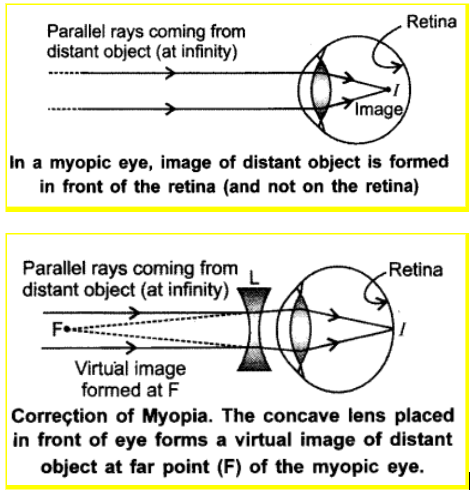
(c) Reasons for donating eyes:
A person’s corneal blindness can only be elevated by a human donor’s cornea.
It is an opportunity to restore someone’s sight.
Methods for supporting this cause:
Make it a family tradition of donating the eyes.
Motivate and educate others about eye donation.
Help remove all the myths . about eye donation.
EXAMPLE 5
(a) What are the values of (i) near point and (ii) far point of vision of a normal adult person?
(b) A student has difficulty in reading the blackboard while sitting in the last row. What could be his defect of vision? Draw a ray diagram to illustrate this defect of vision.

REFRACTION OF LIGHT THROUGH A PRISM
Last chapter me aapne padha ki kis tarah rectangular glass slab se light refract hoti hai.
Rectangular glass slab parallel refracting slab hai jisse light se ray jab cross hoti hai tb emergent ray incident ray ke parallel hoti hai. Jab koi light ray kisi prism se hoker refract hogi to glass slab ke compare me thoda dofferently refract hogi. Ek triangular glass prism lete hai jisme do syrfaces triangular shape ke hote hai or three surface rectangular lateral surface hote hai. Ye surfaces ek duare se inclined hote hai. Do lateral surfaces ke bich ka angle ko angle of the prism.
* Ab hum is triangular glass prism se light ke refraction ko padhne ke liye ek white colour ka heet leker use kisi drwawing board me pin se fix krte hai.
* Is white paper ke uper ek glass prism rakhte hai or pencil se prism ka outline khinchte hai.
* Ab ek light beam ko kisi incident angle pe rakh ke light ray prism k AB surface me incident karate hai jaisa ki niche diye gaye figure me dikhaya gaya hai.
* Ab hum prism ke AC surface se dekhe to ye light beam prism se emerge ho ry hai.
* Emergent ray or incident ray dono hi same straight line me lie kr ry hai jaisa ki aap figure me dekh skte ho ki prism ke ander ek pink colour ki straight line hai.
* Ab jis point pr incident ray prism ke AB surface pr strike kr ry hai us point se ek perpendicular line (NN’) khinchte hai. isi tarah jis point se AC surface se light ray emerge ho ry hai us point se bhi ek perpendicular line (MM’) khinchte hai.
* Ab hum incident beam or perpendicular line jise hum normal ke naam se jante hai unke bich ke angle ko incident angle ∠i, or refracted angle ∠r anf emergent angle ∠e mark karte hai jaisa ki figure me dikhaya gaya hai.
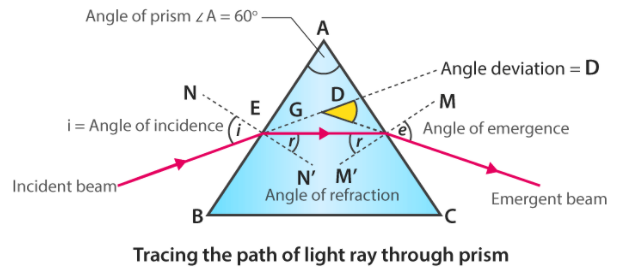
Yaha pr light air se glass (rarer to denser medium) me prism ke AB surface se light ray incident ho ry hai or glass me enter karte hi refract hote hue normal ki taraf bend ho ry or second surface AC me light ray glass se air (denser to rarer medium) me enter kr ry hai islie ye normal se dur ki taraf hatate hue refract ho ry hai. Ager hum dono refracting surface ke angle of incidence and angle of emergence ko angle of refraction se compare kare to prism ka peculiar shape emergent light ray ko incident ray ki direction me hi bend karta hai, jis angle se bend karta hai use hi angle of deviation ∠D kahte hai.
DISPERSION OF WHITE LIGHT BY A GLASS
Jb aap kisi glass prism pr white light enter karwate hai to glass prism white light ko different colours me split kr deta hai.- White light ka different colours me split hona hi dispersion of light kehlata hai.
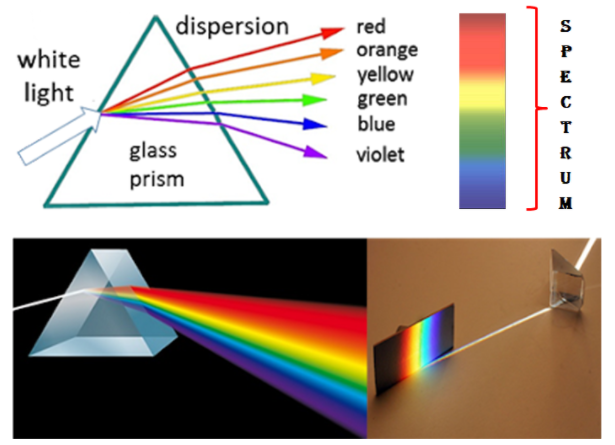
Practical life me dispersion of light ka ek beautiful example hai rainbow. Jaha aap dekh sakte hai sun ki white light different colours me split hoti hai. Iska another example hai kisi CD/DVD ka back side jisme different colours aapne dekha hoga joki rainboe ke jaisa dikhta hai, ye spectrum hai.
Dispersion of light ke karan jin seven colors ki hum baat kr rahe hai wo hai - violet, indigo, blue, green, yellow, orange, red hai.
Ab hum yaha pr baat karenge ki ek simple glass prism kis tarah se kisi white light ko seven defferent colours me split karta hai. Iske liye hume refraction of light ke concept ki jarurt hogi. Yaad kariye ki humne refraction of light me padha hai ki yah bending of light hai. Jaisa ki aap figure me dekh skte hai ki light air se glass me ja ra hai fr glass se air me ja ra hai. White light seven colors se milkar bana hai. Air me sare colours ka speed lagbhag same hota hai 3×108
But jis moment pe light air se glass me hit karta hai us moment me sare colours ki speed change ho jati hai kyuki glass me in colours ki speed alag alag hoti hai. Red light ki speed glass me sabse jyada hoti hai or violet ki speed sbse km hoti hai. Kyuki yah pr different colours ki speed change ho ry hai isliye ye glass prism different angles se bends ho rae hai isiliye split ho rae hai. Jab light glass se air me ata hai tb ek bar or refraction hota hai. Is tarah se glass prism white light ko different colours me split karta hai.
- Sare colours ki speed air me same hoti hai, ager same nahi hoti to hume air me bhi rainbow dikhai deta. Glass prism me different colours ki speed different hoti hai.
Jaisa ki humne dekha ki ek glass prism white colour light ko different colour light me split kr raha hai. Kya hoga ager hum ek or glass prism ko phle prism ke just baad invert karke rakh de jaisa ki figure me dikhaya gaya hai. Is tarah se do prism ko rakhne pr phla prism white light ko different colours me split karega or dusre prism se again recombine white light bahar niklegi.
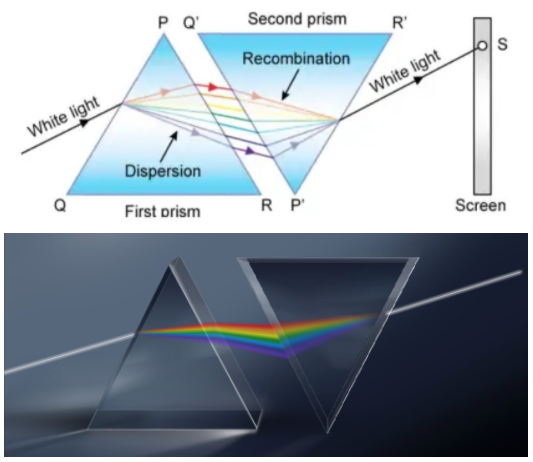
Rainbow
Ab hum nature ke beautiful spectrum rainbow ki baat karenge. Aapne rainbow dekha hoga pr kabhi kabhi, kyuki rainbow dikhne ke liye same time barish or sunshine hone ki jarurt hoti hai joki bht hi rare hota hai or kuchh der ke liye hi hota hai. Ager aap kabhi kisi waterfall ke pass jate hai to waha aap dekh sakte hai ki rainbow dikhta rahta hai. Ye rainbow kaise form hota hai iske liye sun aapke pichhe hona chaiye or aap najare rainfall ki taraf honi chaiye jaisa ki niche figure me show kiya gaya hai. Raindrops chhote chhote prism ke jaisa act karte hai. Ye white light ko seven colours me split karte hai jisse rainbow form hota hai. Yaha pr rainbow form hone ke liye prism ki tarah kevel light ka dispersion hi nahi ho raha blki refraction or reflection bhi ho raha hai.
Ager hum pass se rain drops ko dekhe jaise ki figure me show kiya hai. To hume dikhega ki raindrops ke ander light ka reflection or refraction bhi ho raha hai. Jab white light kisi rain drop me enter kar raha hai to white light seven colours me split ho ry hai kyuki water me different colours ki speed different hoti hai isliye yaha pr light ka dispertion ho ra hai. Iske baad light rays raindrop se air me jane ke bajay raindrop ke ander hi pura reflect horaha hai jise light ka total internal reflection kahate hai. Ye tb hota hai jab light densor (water) se rarer (air) me jati hai or light ka incident angle water ke critical angle se badha hai. Is condition me sare colours refract hone ki jagah total internal reflect ho jate hai. Ab sare 7 colours raindrop se bahar jane ki kosis karenge. Is time pr light ka incident angle water ke critical angle se chhota hota hai isliye light rays refract ho jati hai. Is tarah se hume rainbow me 7 colours dikhai dete hai.
POINT 3
1. Definition of Dispersion of light - splitting of white light into its constituents colours
2. Definition of Spectrum - band of colours formed by dispersion
EXAMPLE 6
Draw a diagram showing refraction of a ray of light through a glass prism and mark the angle of deviation.
Or
Draw a ray diagram to explain the term angle of deviation.
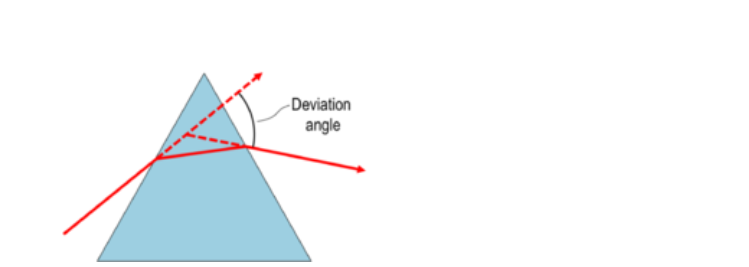
The angle between the directions of incident ray and emergent ray from the prism is called angle of deviation.
EXAMPLE 7
Draw the diagram on your answer sheet showing the different colours on the white screen when white light passes through a glass prism.
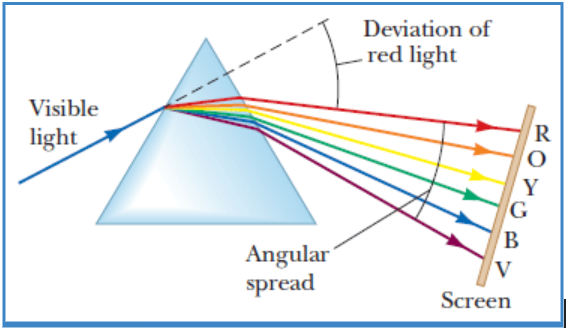
EXAMPLE 8
What is the order of wavelength of visible light ?
The order of wavelength of visible lights is 10−7m.
EXAMPLE 9
A narrow beam of white light is shown to pass through a triangular glass prism. After passing through the prism, it produces a spectrum XY on a screen.
(a) State the colour seen at XandY.
(b) Why do different colours of white light bend through different angles with respect to the incident beam of light ?
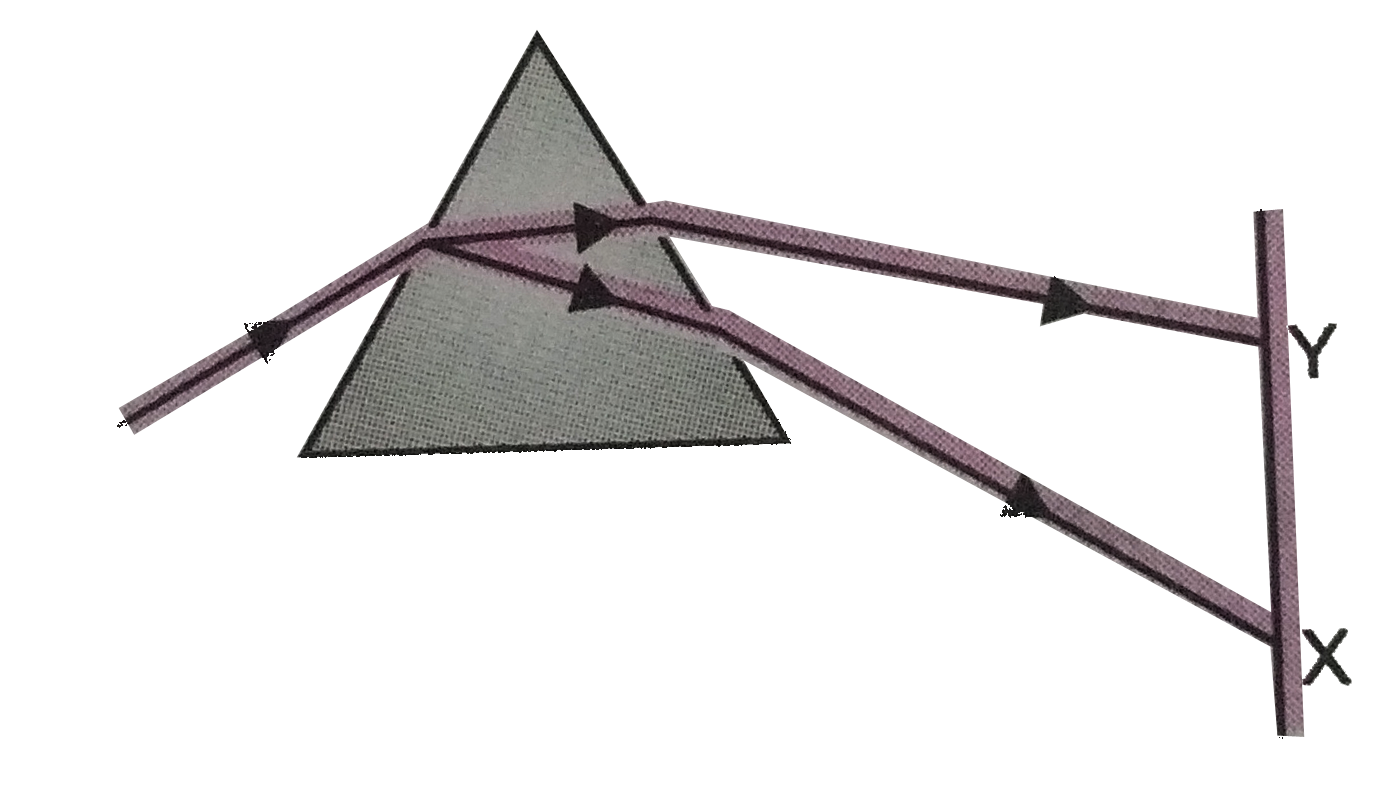 .
.
(a) Colour seen at X is violet, and colour seen at Y is red.
(b) Different colours bend through different angles because speed of different colour through glass is different and hence refraction index of glass for different colours is different.
EXAMPLE 10
What is dispersion of light ? (CBSE 2012, 2015, CBSE (Foreign) 2016)
The phenomenon of splitting white light into seven colours when it passes through a glass prism is called dispersion of light.
EXAMPLE 11
What is the cause of dispersion of light ?
Or
State the cause of dispersion of white light by a glass prism.
When white light passes through a glass prism, its constituent colours (red, orange, yellow, green, blue, indigo, violet) travel with different speeds in the prism. This causes the dispersion of light.
EXAMPLE 12
What is dispersion of light ? What is the cause of dispersion ? Draw a diagram to show the dispersion of white light by a glass prism.
Dispersion of Light: The phenomenon of splitting white light into seven colours when it passes through a glass prism is called dispersion of light.
Cause of Dispersion: When white light passes through a glass prism, its constituent colours (red, orange, yellow, green, blue, indigo, violet) travel with different speeds in the prism. This causes the dispersion of light.

EXAMPLE 13
When white light passes through a glass prism, seven colours namely red, orange, yellow, green, blue, indigo and violet are seen on the white screen. All these colours have different angles of deviation. Explain why ?
Speed of colour in a medium depends upon its wavelength. All the colours have different wavelengths. The red colour has the longest wavelength and violet colour has the last wavelength. Therefore, red colour has the highest speed in the glass prism and the violet colour has the lowest speed in the glass prism. Hence, all colours of white light are refracted by different amounts while passing through the glass prism.
Therefore, all the colours have different angles of deviations.
EXAMPLE 14
Why do different colours get separated when white light passes through prism I How can we recombine the components of white light after a prism has separated them ? Explain with the help of a figure. (CBSE 2012)
Different colours have different speeds in glass prism. Due to this fact, different colours get separated while passing through the prism.
Perform an activity to show that the colours of white light splitted by a glass prism can be recombined to get white light by another glass prism.
Apparatus required: Two glass prisms made of the same kind of glass, a cardboard having a fine hole at its centre, a white screen.
Procedure:
1. Place a cardboard in front of a prism A. A ray of white light coming from the hole in the cardboard falls on the prism A (Figure 11).
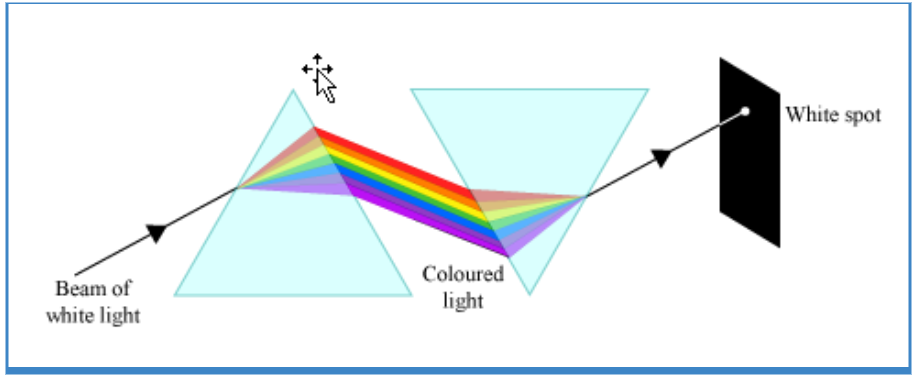
2. White light splits into seven colours by prism A is made to fall on another glass prism B placed with its base upward. Since prism A disperses white light, so it is known as dispersing prism.
3. The prism B deviates colours of light towards its base. The various colours recombine at the opposite lace of glass prism B.
4. This activity was initially performed by the great scientist Issac Newton.
The light received on the white screen placed in front of prism B is white. Since the prism B recombines the colours of light to produce white light, so glass prism B is known as recombination prism.
EXAMPLE 15
How will you use two identical glass prisms so that a narrow beam of white light incident on one prism emerges out of the second prism as a beam of white light ? Draw a labelled diagram to illustrate it.
Perform an activity to show that the colours of white light splitted by a glass prism can be recombined to get white light by another glass prism.
Apparatus required: Two glass prisms made of the same kind of glass, a cardboard having a fine hole at its centre, a white screen.
Procedure:
1. Place a cardboard in front of a prism A. A ray of white light coming from the hole in the cardboard falls on the prism A (Figure 11).


2. White light splits into seven colours by prism A is made to fall on another glass prism B placed with its base upward. Since prism A disperses white light, so it is known as dispersing prism.
3. The prism B deviates colours of light towards its base. The various colours recombine at the opposite lace of glass prism B.
4. This activity was initially performed by the great scientist Issac Newton.
The light received on the white screen placed in front of prism B is white. Since the prism B recombines the colours of light to produce white light, so glass prism B is known as recombination prism.
EXAMPLE 16
How did Newton, using two identical glass prisms, show that white light is made of seven colours ?
Investigate dispersion of white light in a glass prism
1. Place a thick cardboard having a small hole in it in front of a glass prism.
2. Allow sunlight to fall on the cardboard. The hole in the card board allows a beam of white light to fall on the prism.
3. Place a white screen at some distance away from the prism.
4. Rotate the prism slowly until a band of seven colours is figure 9 observed on the white screen.
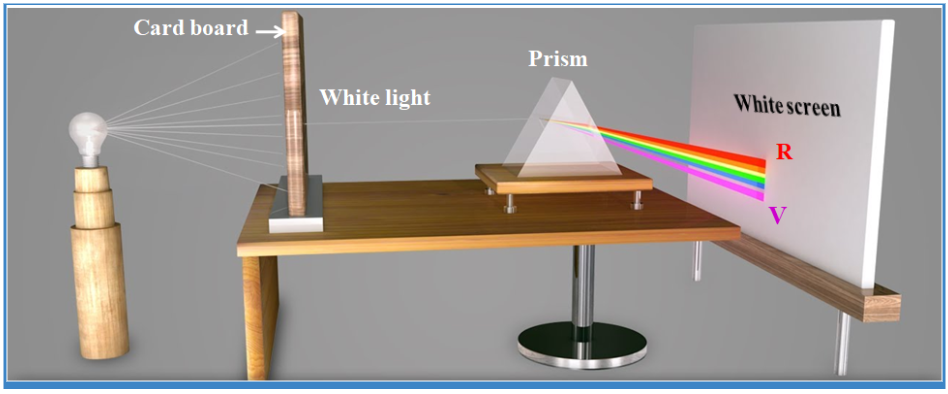
Conclusion : “When a beam of white light falls on a glass prism, white light splits into its constituent colours (i.e., seven colours). This phenomenon of splitting white light into seven colours by a glass prism is known as dispersion of white light.
EXAMPLE 17
Why do we observe the seven colours when white light passes through a glass prism ? Which component of white light deviates the least ?
White light is a mixture of seven colours. The speed of different colours of white light is different in glass. So when white light passes through a glass prism, it splits into seven colours. Red colour deviates the least.
EXAMPLE 18
Why do we see a rainbow in the sky only after rainfall ?
You must have seen a beautiful rainbow in the sky after rainfall. This rainbow is formed due to the dispersion of sunlight.
When sunlight falls on the water drops suspended in the atmosphere after rainfall, a rainbow is formed due to the dispersion of sunlight. The water drops suspended in air (or atmosphere) act as prisms.
Rainbow is the example of dispersion of sunlight. The formation of a rainbow after rainfall is shown in figure.
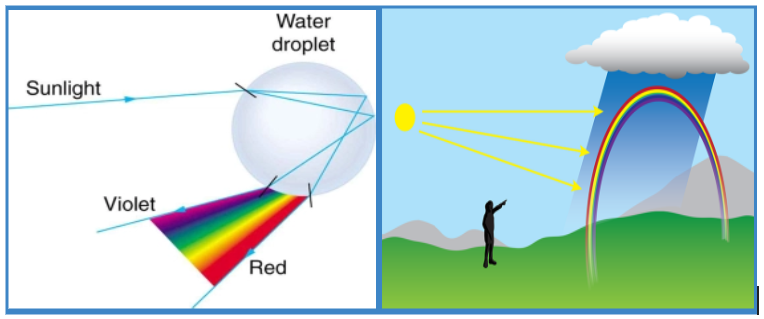
Rainbow is observed during a rainfall or after the rainfall or when we look at a water fountain provided the sun is at the back of the observer.
Conditions for Observing a Rainbow
When sunlight falls on a water drop suspended in air, then the sunlight is refracted. The refracted sunlight splits (or dispersed) into its constituent colours (i.e., seven colours). Thus, water drop suspended in air behaves as a glass prism. The red colour deviates the least and the violet colour deviates the most. Different colours of refracted sunlight fall on the opposite face of the water drop.- Now, each colour suffers internal reflection. The reflected colours on reaching the lower surface of water drop are refracted again into the air. Thus, we get a spectrum of seven colours, which is known as a rainbow.
EXAMPLE 19
Explain refraction of light through a glass prism using a labelled ray diagram and hence define the angle of deviation.
Refraction of Light Through a Prism
Prism is a homogeneous transparent refracting medium bounded by at least two non-parallel surfaces inclined at some angle.
A commonly used prism is shown in figure .
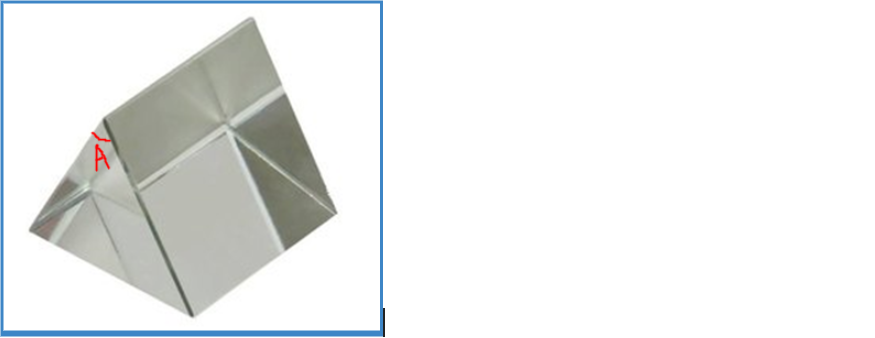
The two non-parallel plane surfaces participating in the refraction of light are called refracting surfaces. The angle between two non-parallel refracting surfaces is called angle of prism or refracting angle. It is denoted by A.
Find Angle of deviation of a ray of light passing through the prism Procedure
1. Place a glass prism on a sheet of white paper.
2. Mark its boundary with H.B. pencil.
3. Now fix two pins at points R and S as shown in figure .

4. Look through the refracting face ac and fix two pins at P and Q such that the pins H and I and the images of pins R and S line in a straight line.
5. Now remove the prism and all pins.
6. Join the points R and S and extend this line so that it touches the refracting surface ab at point E.
7. Also join the points P and Q and extend this line so that it touches the refracting surface ac at point G.
8. Also join points E and G.
9. Draw perpendiculars NN‘ and MM‘ on the refracting surface ab at point E and on the refracting surface ac at point G
10. ∠NES=∠i, angle of incident and the ray RSE is the incident ray.
11. ∠MGP=∠e, angle of emergence and the ray GPQ is the emergent ray.
12. Produce the emergent ray GPQ backward so that it intersects the incident ray produced forward at point J.
13. ∠FJG = ∠D, angle of deviation of the incident ray of light passing through the prism.
Thus, angle of deviation of a ray of light is defined as the angle between the directions of incident ray of light and the emergent ray of light.
ATMOSPHERIC REFRACTION
Aap sabhi bachho ne bachpan me ye poem to padhi hi hogi - twinkle twinkle little star. Pr kya aapne kabhi socha hai ki ye star kyu twikling karte hai? Actually star jis position me hote hai usse thode uper kyu dikhai dete hai? Sunrise hone se do minute phle hi atmosphere me sun kyu dikhai deta hai? Isi taraf hum sunset ke bad bhi agle do minute tk sun ko kyu dekh pate hai? In sare question ka answer hume is atmospheric refraction me milega.
Twinkling of stars
Night sky me aapne stars ko twinkle karte ya timtimate hue dekha hoga pr kya aapko pta hai ki jab astronaut space me stars ko dekhte hai to black sky me bright stars dikhte hai, waha stars twinkle nahi hote. Kyu stars earth me twinkle hi twinkle karte hai? Aisa earth ke atmophere ke karan hota hai. Atmosphere me stars ki light refract hoti hai, is tarah se atmopheric refraction ki wajah se stars twinkle karte hai.Ise samjhne ke liye hum ek simple example lete hai ki jab hum bone fire karte hai to hum dekhte hai ki fire ke uper or aaspass ki light flickring karti hai.

Aisa isliye hota hai kyuki fire ke uper or aas pass ka air hot hota hai joki cool air ke compare me less dense hota hai. Isliye bulb se aane wali light refract hoti hai or light band ho jati hai. But air ki layer constantely shift hote rahti hai mtlb air to bahate rhti hai n constant to nahi rahti isliye bulb se aane wali light randomly refract hoti rahti hai isliye ye flickring effect deti hai joki fire ke pass dikhti hai ager ab kahi dur se is fire ke uper tiny lights ko dekhenge aapko twikling karte huye dikhai dega.
Hoter air ka refractive index cooler air ke compare me less hota hai isliye light refract hoti hai. Isliye humari aankhon me enter karne wali light change hoti rehti hai joki twinkling effect deta hai. Is tarah hum twinkling of stars ko smjh sakte hai. Atmosphere air ke different layers se mil ke bana hai jisme layers ke temperaturs different hote hai. Cooler air warm air se jyada dense hote hai isliye alag alag layers me optical density alag alag hoti hai.
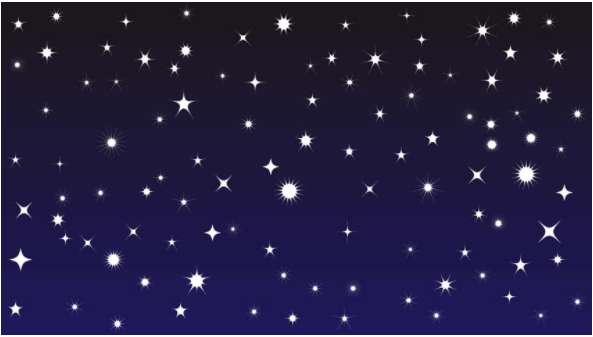
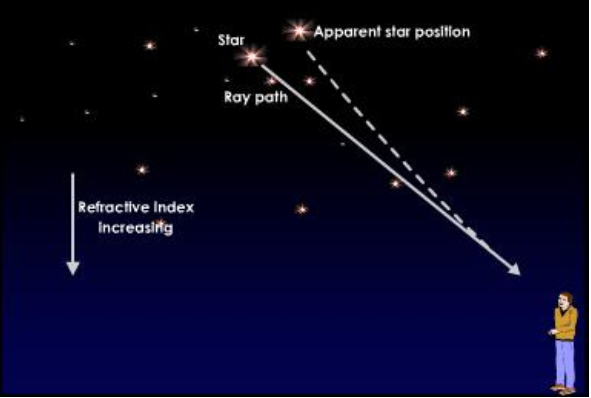
Ab agar hum stars ki taraf dekhe to stars se aane wali light air me enter karti hai to light vacuum se air me enter karti hai or light refract hoti hai. Jaise ki a b a b humne smjha hai ki air me bht sare layers hote hai to light jab different layers se hoker niklti hai to layers ki optical density different hone ke karan kai bar light ka refraction hota hai. Jab light rays humari eyes tk phuchti hai tb tk light me bht sare refraction ho chuke hote hai isliye jb hum apni position se star ko dekhte hai to hum wo apparent position me dikhai deti hai kyuki air apni position continuously change karti rahti hai isliye star ki apparent position bhi continuesly fluctuate hoti rahti hai. Stars ki Light jis path se aati hai wah change hote rahta hai isliye humari eyes me enter karne wala light ka amount bhi change hote rahta hai. As a result star kabhi bright dikhta hai kabhi dim dikhta hai. Star ki light ke is bright dim bright dim dikhne ke karan stars hume twinkle krte hue dikhte hai.
Ager hum planets ke baare me soche to planets kyu hume twinkle karte hue nahi dikhai dete? Iska karan ye hai ki planets stars ke compare me earth se bht jyada pass hote hai or star ke compare hume bade dikhai dete hai. Stars earth se bht dur hone ke karan point jaise dikhai dete hai joki light ke point source hote hai jbki planet light ke extended source hote hai. Yahi karan hai ki planet se aane wali light me twinkle karti hui appear nahi hoti.
- Twinkling of stars is due to atmospheric refraction.
Advance sunrise and delayed sunset
Atmospheric refraction ke karan hone wala next effect hai early sunrise or delayed sunset.Kya aap jante hai ki sun hume actual sunrise se 2 minute phle dikhai deta hai or sunset ke do minute baad bhi hume sun dikhai deta hai? Ab hum dekhenge ki aisa magic kaise hota hai ki jab sun horizon ke niche hota hai fr bhi hume dikhai kyu deta hai.
Aap imagine kariye ki aap sea bich me khade hai hai or sunrise ka wait kr rahe hai or sun horizon line ke niche hai. Horizon ka mtlb kya hota hai? Horizon ka mtlb hota hai jaha pr sea line or sky line aapas me milti hui appear hoti hai use horizon kahte hai. Ye aapko achche se dikhega jab aap sea ke samne se khade hoker dekhte hai.
Imagine kijiye ki aap earth ke uper surface me khade hai jaisa ki niche diye gaye figure me dikhaya gaya hai or aapke just samne horizon line pr sun hai. Ager waha pr koi atmosphere nahi hai to aap aasani se dekh skte hai hi sun jis position pe hai aapko bhi wahi pr dikhega.
Ager waha pr atmosphere present hai to joki light ka refraction kr deta hai. Jab aap is tarah se sun ko dekhe to sun se aane wali light aapki taraf band hoti hui aaegi or aapki eyes tk phuchegi to us point se sun aapko apparent position pr dikhai dega joki actual position se thoda uper hoga. Yahi karan hai ki hum sunrise hone se phle hi sun ko dekh pate hai joki approx 2 minute phle hota hai.
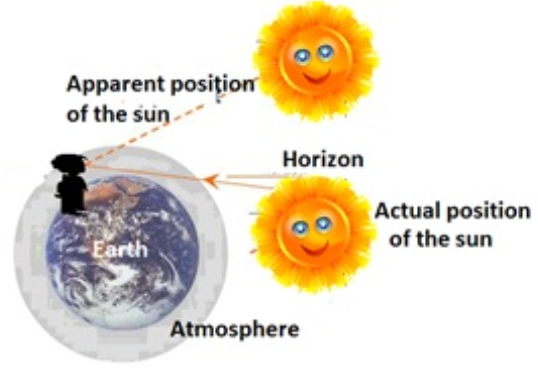
Thik isi tarah se jab sun set hota hai to sun horizon ke niche jata hai to. Once again light less dense se more dense medium me jata hai or light ka bht bar refraction hota hai. Sunlight aapki taraf band hogi or aapko sun horizon ke uper dikhai dega joki sun ka apparent position hoga joki sunset ke do min baad bhi sun dikhega. Is tarah se daily 2+2=4 min humara din longer hota hai.
- Ye sare effects optical illusions hai joki atmospheric refraction ke karan hote hai.
POINT 4
1. Definition of Atmospheric Refraction- The refraction of light by the Earth's atmosphere is known as atmospheric refraction.
SCATTERING OF LIGHT
Kyu sunrise ke time sun red dikhta hai? Kyu hum light ki beam ko dust bhare room pe dekh skte hai? Kyu danger signal ke liye light red colour ki hoti hai? It is due to reflection of light refraction of light or dispertion of light? Ye in teeno me se kisi phenomena ke karan nahi hota ye ek different phenonmeon ke karan hota hai scattering of light jiske kuchh examples niche figures me dikhaye gaye hai.
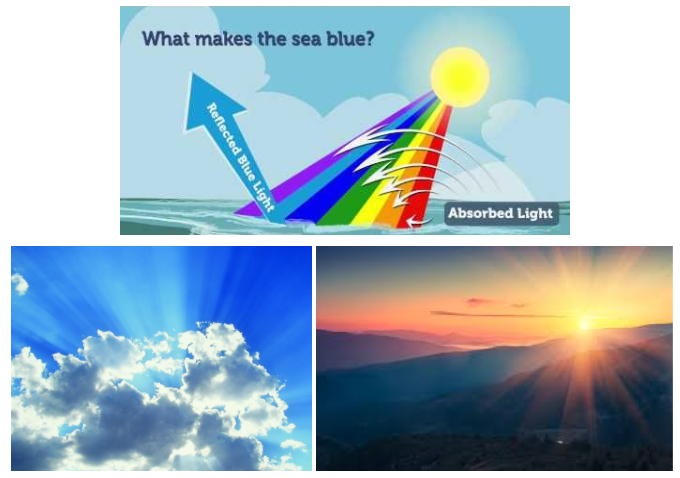
Hum yaha pr scattering of light ke concept ko bada hi easy karke smjhenge. Agar kisi torch ko on kare to kya aap light ki beam ko dekh skte hai? Nahi kyuki light invisible hoti hai pr wahi ager hum torch ke samne apne hath rakh de ho humari hatheli pr light dikhai padti hai kyuki humare hatho se light reflect ho ry hai jise hum dekh pa rae hai. Aap imagine karo ki aap kisi dust se bhare room pe ho or ab torch on karke dekhte ho to aap dekh skte hai torch ke light ki beam ko. Ye sb kaise ho raha hai? kyon ki bht sare dust particle light beam ko scatter kr ry hai.
Jaisa ki humne discuss kiya ki light dust particle se scatter hoti hai but light aur other particles se bhi scatter hoti hai jaise ki air molecules and water droplets. Ab hum dekhenge ki ye particles light ko kaise scatter karte hai. Ager hum consider kare ki light wave ki tarah hai to hum dekhenge ki dust particles light waves ko different - different direction me reflect karti hai jise hum scatterred reflection kahte hai. Or hum kah skte hai ki particle light ko random direction me scatter kr rahe hai. Ager ab hum light ko particle ki tarah consider kare jo ki photons se bana hota hai to hum kah skte hai ki ye particles photons ko observe kr rahe hai or reemit kr rae hai different random direction me to light random direction me reemit ho ry hai isliye hum kah skte hai ki light scatter ho ry hai. Ager hum ye soche ki kya alag alag particles light ko same way me scatter karte hai to nahi aisa nahi hota. Hum inhe compare krke dekhte hai. Different size ke particles different way me light ko sacatter karte hai.
Atmospheres me bht sare different particles present hote hai. In different particles se different scattering ko samjhne ke liye hum light ko uske wavelength ke base pe devide krenge. Wavelength means length of one wave.
To visible light ka wavelength ka range 400nm to 700nm hota bai.hum in bht sare atmosphere ke particles ko two parts me classify karenge joki ek to hoga visible light ke wavelength se chhote particles or dusre visible light ke wavelenth se bade particles. Jaisa ki nitrogen or oxygen ke particles bht hi chhote 0.4 nm ke hote hai joki visible light ke wavelenth se bht hi chhote hote hai. Water droplets ya dust particles 1000nm ke size ke hote hai joki visible light ke wavelength se bht bade size ke hote hai. Phle hum larger particles se scattering of light ko analyse karenge.
Jab sun ki white light larger particles jaise ki dust particle pr padti hai. Simplicity ke liye hum consider kr lete hai ki white light three primary colors se bana hai red green or blue. Hum ek single dust particle consider karte hai. One dust particles sare colours ko equally scatter karta hai. Jab white light is dust particle se scater hota hai to wo light ko white colour me appear kar raha hai. Imp point ye hai ki bht sare light dust se straight pass ho jate hai. Most of the sun light dust se straight pass ho jate hai or small amount of dust particles se scatter hota hai. Agar aap dust se bhare room me torch ki light jalate hai to light ki beam ka colour white hota hai. Kyunki dust particles sare colours ko sare direction me equally scatter karta hai isliye light beam white colour ka dikhta hai.
Ab hum air particle ko consider krte hai jisme nitrogen or oxygen molecules hote hai jo visible light ke wavelength se smaller hote hai. Agar sun ki white light air molecule pr pdti hai to air molecule light ke different colour ko differently scatter krte hai kyuki different colours ki wavelength diferent hoti hai or jin particles ka wavelength light ki wavelength se km hota hai wo light ko bht jyada scatter krte hai jo ki light ke colours pr depend krti hai. Ager hum VIBGYOR colours me se three measure colours red green or blue ko consider kare to Blue colour ka wavelength sbse km hota hai joki red colour se 10 time jyada scatter hota hai isliye blue colour sbse jyada scatter hota hai, jise air molecule sbse jyada scatter krta hai. Hum jante hai ki sun light white colour ka hota hai joki 7 colours se milker bana hota hai or atmosphere air molecules se sbse jyada milkr bana hota hai. Air molecule sbse jyada blue colour ko scatter kr raha hai aisa jaise air molecule blue colours ke powder se khel raha ho or sabhi taraf blue scatter kr raha ho. Yahi karan hai ki jab hum sky ko dekhte hai to wo hume blue dikhta hai.

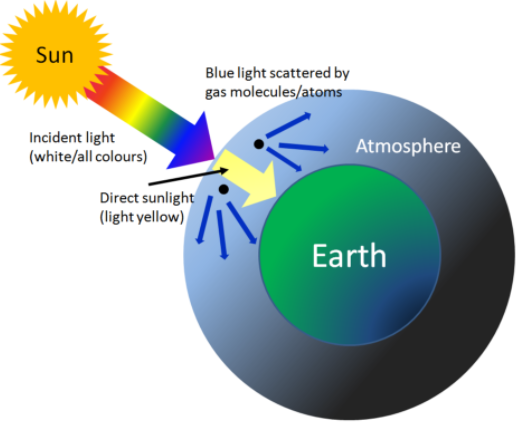
Agar koi atmosphere na ho to sky ka colour black dikhega jaise ki koi astronaut jab atmosphere se bahar sky ko dekhta hai to use black colour ka sky dikhai deta hai kyuki jaha atmosphere nahi hota waha light ko scatter karne ke liye koi particles present nahi hote. Isiliye bina atmosphere ke sky black dikhta hai.
Sun ab bhi white colour ka hi hota hai. Iska mtlb hai ki sky ka blue colour hona ek opticle illusion hai jo ki air molecules ke dwara preferentially blue colours ko scatter karne ke karan hota hai.

Ab humne dekha ki sky blue colour ka hota hai but clouds ke bare me soche to clouds white kyu hote hai? Kyuki clouds water droplets or dust particles se bane hote hai. Jaisa ki humne already discuss kiya hai ki ye particles light ke wavelength se large hote hai joki sare colours ko equally scatter krte hai. Isliye jab sun ki white light clouds ke particles pr padti hai to wo sare colours ko equally scatter karne ke karan scattered light white hi hoti hai or clouds hume white colour ki dikhti hai.
Tyndall Effect
Aapne aisa image dekha hoga jaha Sun rays ka path visible hota hai.
Isi tarah aap light beam ko tb bhi dekh rakhte hai jb aap light ko kisi collide se pass kare pr aap jab kisi solution se light ko pass krte hai to aapko light beam nahi dikhai dega. Scattering of light ka ye effect tyndall effect kehlata hai. Kyuki scattering of light ke tyndall effect ko collide hi show kr ra hai koi solution show nahi karta isiye tyndall effect ka use collide ki testing me kiya jata hai.
Ek experiment karke dekhte hai, yaha pe humne pani ke do glass liye hai. Inke through agar hum red colour ki ek laser light ko shine krwate hai. Phle glass me humne sugar milaya or dusre glass me kuchh bhi nahi milaya to hume glass me se koi bhi light nahi dikhegi pr hum dusre glass me ager milk add kre thoda sa to hum light beam ki path dikhne lagegi. Milk ko glass me add krne se milk ke sare particles glass me fail (disperse ho) ja rae hai. Light ki rays is milk particles pe padke reflect ho ry hai. Milk ki ek particle ko smjhne ke liye consider krte hai. Jab light ek particle pr pdti hai to milk ke particles bht jyada chhote hone ke karan light ko bht sare directions bikher deti hai jaisa ki niche figure me dikhaya gaya hai.

Hume last chapter me dekha tha ki bade bade particle jaise ki mirror me light ray pd ry thi to ek hi direction me reflect kr rahi thi pr chhote particles ke liye ye true nahi hai. Chhote particles light ko scatter kr dete hai. Pr yahi chhote paricles mil ke jab kisi bade object ko bnate hai to reflection kevel ek hi direction me hota hai. Chhote particles jab light ko many direction me bikher de ry hai to ise hum scattering of light kahte hai. (scattering of light mtlb light ko bikher dena.)
Ye chhote particles se scatter hone wali light ko hum kahi se bhi dekhe to wo particles se scatter hone wale light ka kuchh hissa to hume dikhega hi. Light pura pura particles se reflect nahi hota blki kuchh light sidhe aage bhi chala jata jaise fig me particle ke right direction me aerrow bna ke dikhaya gaya hai. Is tarah se milk mile glass ke jin jin particles se light hoker gujarti hai Wo hume glow dikhne lgti hai isi liye hume light beam ki path visible ho jati hai. (Red colour ki straight line visible hoti hai).
Jab light sugar solution se pass karti hai to red light ka path hume kyu ny dikhai de ra. Kyuki bade particles light ko jyada amount me scatter karte hai to wo hume dikhti hai bt bht jyada chhote particles km amount me light ko scatter karte hai isliye normal eyes se hume light beam nahi dikhai deti. Suger solutions ya kisi bhi solutions ke case me yahi hota hai kyuki solutions ke particles bht hi jyada chhote hone ke karan km scatter karne ki wajah se light fant ho jati hai or hume dikhai nahi deti. Ager particle ki size bht jyada badi ho jaye man lo 1000nm to problem ho jaegi jaise ki dust particles ke bare me humne smjha. Ager hum in dust particles ko water me milaye to gravity ke karan wo kuchh der me settle down ho jayenge isiliye kuchh der ke liye hi light ko scatter karenge fr settlle down hone ke bad light ki path me koi dust particle present hoga hi ny isiliye light beam visible bhi nahi hogi.
1nm se 1000nm ke bich ke particles wale mixture ko hum bolte hai collides. Aise mixtures jinme particles ke size 1nm se chhote ho unko bolte hai solutions or ye scattering ko dekhne ke liye worst hota hai kyuki ye light ko fant kr dete hai or hume scattering nahi dikhti. Jin mixtures me particles ka size 1000nm se bada ho use hum suspension bolte hai jo ki gravity ke karan settle down ho jane se light ke path me koi partoicles bachte hi nahi hai or hume scattering dikhti hi nahi hai.
Jab hum collide ke case me scattering ki baat karte hai to ise hum tyndall effect.
Why is the colour of the clear Sky Blue?
Kya aapne kabhi ye socha ki humari sky blue colour ki kyu dikhti hai humara sun jo ki white colour ka hai ye dopaher me yellow colour ka kyu dikhta hai? Sunrise or sunset hume red color ki kyu dikhti hai?Humare atmosphere ke particle oxygen nitrogen wagarah blue colour ki light ko jyada scatter karte hai compare to red colour ki light.
Humne smjha hai ki jab light ek chhote se particle pr padti hai to ye particle light ko hr direction me bikher deta hai scatter kr deta hai jb ye scatter light humari aankho me padti hai to hume ye particle usi colour ka glow karta hua dikhta hai jis colour ke light ko scatter kiya ho.

Humari sunlight white colour ki hoti hai humne baat kiya hai ki white colour ki light sare colour ko combine karke banti hai. VIBGYOR ke sare colour ko combine kare to white light milne wala hai. Niche diye gaye figure me aap dekh skte ho ki sun ki white light particles me pd ry hai mtlb particles me sare colour ki light ek sath pd ry hai. Lekin humare atmosphere ke particles Violet light ko bht jyada scatter karte hai or red colour ko bht km scatter karte hai. Violet colour ki wavelength sbse km hoti hai joki jyada duri tk travel nahi kr pati isliye blue light hi scatter hoke humari eyes me pdti hai or sky hume blue dikhata hai. Sun ki light puri puri scatter nahi hoti balki kuchh light bina scatter hue directly straight bhi chali jati hai joki white light hoti hai jaisa ki niche figure me shown hai. Isi liye hume sky or sun alag alag colour ki dikhti hai.
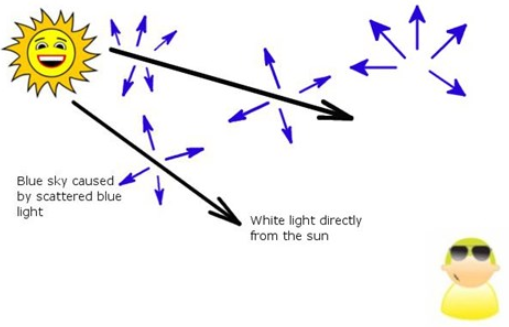
COLOUR OF SUN RISE AND SUN SET
Sunrise or sunset ke time pe sun red colour ki dikhai deta hai. Kyu? Aap sabhi ne sunrise se jyada sunset dekha hoga. Jab sunset hota hai to niche dikhaye gaye figure ki tarah hume sun red colur ka appear hota hai.
Ise smjhne ke liye ager aap imagine karo ki niche dye gaye figure ki tarah hi aap earth ke uper khade ho or sun thk horizon pr ho to sun ko earth tk phuchne ke liye largest distance horizon ke pass travel karna padta hai. Kyuki hum tk phuchne ke liye is time pr sun ko largest distance travel karna pd raha isliye is time pr hi sun ki light sbse jyada scatter hogi. Sunlight white light hoti hai joki 7 colours se milkar bana hai jisme se hum simplicity ke liye three main colours ko fr yaha consider karte hai red, blue or green. Blue light ka wavelength sbse km hota hai to wo sbse jyada scatter hoti hai. Kyuki sunset ya sun rise ke time pe sun horizone pe hone ke karan jab sbse jyada blue light scatter hoti hai to line of sight se mostly scatter blue light bahar chali jati hai or hum tk blue light phuch nahi pati. Green light bhi scatter hoti hai pr humari eyes tk nahi phuch pati. Kyuki red light sbse km scatter hoti hai isliye wo line of sight se bahar jane ke bjay sbse jyada humari eyes tk pahuch pati hai kyuki in colours ka wavelength red coloure ke compare me km hota hai or km length ka waves jyada lambi duri tk travel nahi kr pata. Isliye hume sun ka colour sunset or sun rise ke time pe hume red colour ka appear hota hai. Small amount ka blue or green colour bhi humari eyes tk phuchta hai bt red colour sbse jyda amount me phuchta hai kyuki red colour sbse km scatter hota hai. Isliye much more amount me red phuchne ke karan is time pe hume red appear hota hai.

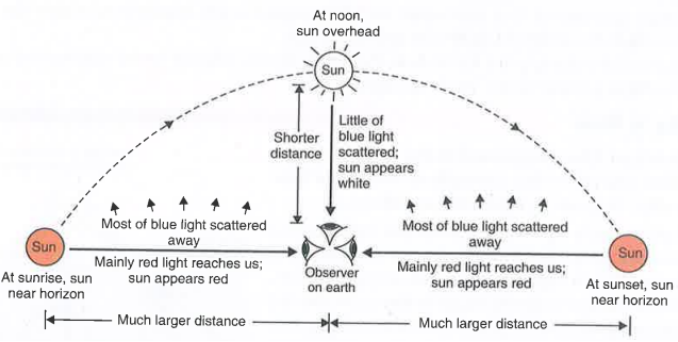
Ab hum baat karenge ki noon me sun white colour ki kyu appear hoti hai. To aap fr se khud earth surface pr assume kr lijiye to agar aap yaha se dekhenge sun ko to sun light ko travel karne liye sbse km distance travel krna padta hai humari eyes tk phuche ke liye. Again blue colour sbse jyada scatter hoga, green colour less scatter hoga and red colour sbse km scatter hoga. Kyuki sun light smallest distance travel kr raha hai to sare colours ka bht hi km scattering hoga isliye sare hi colours humari eyes tk phuch pate hai. Isliye sun hume noon me white appear hote hai.
Ager hum danger signal light ki baat kare to ye humesha red colours ki kyu hoti hai? Aisa isliye hota hai kyuki red colour ki wavelength sbse jyada hoti hai joki smallest distance travel karne ke karan sbse km scatter hota hai isiliye wo largest distance tk bhi travel kr pata hai jaisa ki sunrise or sun set me ho raha tha. Isliye red colour hume dur se bhi directely dikhai de skta hai or hum kisi danger se alert ho skte hai.
POINT 5
1. Definition of Scattering of light- Scattering of light is the phenomenon in which light rays get deviated from its straight path on striking an obstacle like dust or gas molecules, water vapours etc. Scattering of light gives rise to many spectacular phenomena such as Tyndall effect and the “red hues of sunrise and sunset”.
EXAMPLE 20
What is meant by scattering of light ?
When sunlight enters the atmosphere of the earth, the atoms and molecules of different gases present in the atmosphere absorb this light. Then these atoms and molecules of the gases re-emit light in all directions. This process is known as scattering of light. The atoms or particles scattering light are known as scatterers.
The intensity of scattered light is inversely proportional to the fourth power of the wavelength of incident light, if the size of the particles (say atoms or molecules) scattering the light is less than the wavelength of the incident light.
EXAMPLE 21
We can see the sun for a few minutes even after it has actually set. Explain, why ?
Or
Explain with the help of a diagram why the sun is visible to us two minutes before the actual sun-rise and two minutes after the sunset.
We can see the sun for few minutes even after it has actually set.
Actual sun sets when it is below the horizon in the evening. The rays of light from the sun below the horizon reach our eyes because of refraction of light through the atmosphere. These rays appear to come from the apparent position of the sun which is above the horizon as shown in figure.
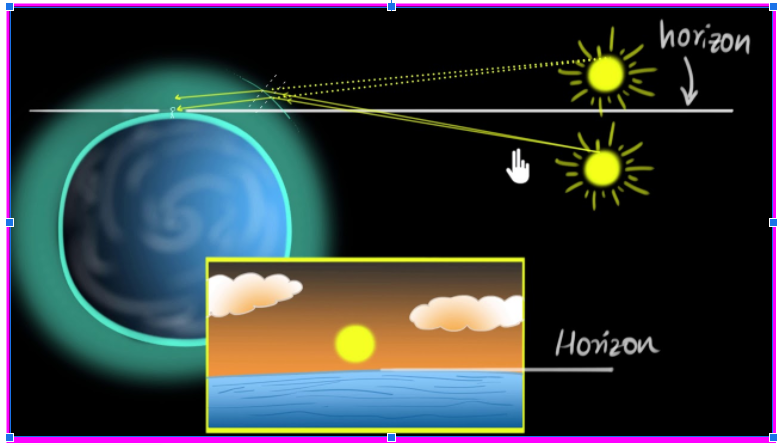
Hence we can see the sun for a few minutes (about 2 minutes) even after it has actually set. Similarly, the sun can be seen about 2 minutes before it actually rises. Thus, we gain about 4 minutes of additional daylight each day.
EXAMPLE 22
Why does the sun appear oval at sunset and sunrise but appears circular at noon ?
The sun appears oval (or flattened) at sunset and sunrise but appears circular at noon
At sunset and sunrise, the sun is near the horizon. The rays of light from the upper and lower edge of the sun bend unequally while travelling through the atmosphere. As a result of this phenomenon, the sun appears oval or flattened (Figure).
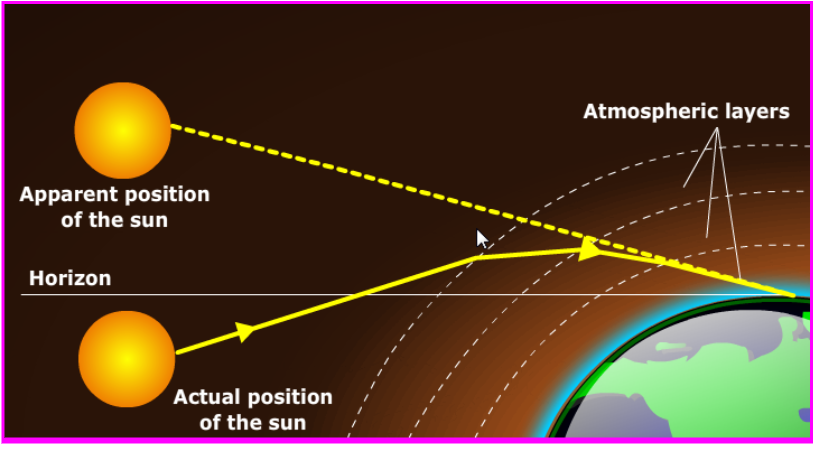
At noon, the sun is overhead. The rays of light from the sun enter the atmosphere normally and hence they do not bend at all while passing through the atmosphere. Therefore, the sun appears circular at noon.
EXAMPLE 23
Why is the colour of clear sky blue ? Explain.
Or
Why does the sky look blue on a clear day ?
When sunlight enters the earth’s atmosphere, the atoms or molecules of the gases present in the atmosphere scatter this light. Since the wavelength of red colour is larger than the wavelengths of other colours in sunlight, so red colour is scattered least. Violet colour is scattered the most followed by blue, green, yellow, orange and red colours respectively. Our eye is more sensitive to the blue light than the violet light. Therefore, scattered light in the sky contains blue colour in plenty and hence the clear sky appears blue.
Note : Sky appears greyish over cities having industrial units. The smoke and dust particles in the atmosphere over such cities scatter red, orange and yellow colours more than other colours of small wavelengths. Hence, the sky appears greyish.
EXAMPLE 24
Why are stop signals on roads in red coloured light ?
When light falls on the signal, all colours are scattered much more than that of red colour. So the red colour suffering least scattering remains confined around the signal, which in turn illuminates the signal significantly. Thus, the danger signals can be seen from very far off distances. Moreover, among all colours, red colour or red light is scattered least by smoke or fog. Hence, red signals are visible even through the smoke or fog.
EXAMPLE 25
(a) What would have been the colour of sky if the earth had no atmosphere ? Give reason for your answer.
(b) State the difference in colours of the sun observed during sunrise/sunset and noon. Give explanations for each.
(a) If the earth had no atmosphere, the colour of the sky would have been dark. The colour of sky depends on the scattering of sunlight due to the atmosphere. No atmosphere means no scattering of light.
(b) The colour of the sun observed during sunrise/sunset is reddish, while its colour observed at noon is white. At sunrise/sunset, the sun is very far away from the observer. So, the sunlight travels a longer distance through the atmosphere to reach the eyes of the observer. The scattering of blue light is more than the scattering of red light. So, more red light reaches our eye and hence the sun appears reddish.
During noon the sun is overhead and light from the sun travels less distance through air to reach our eye. In this case, scattering of all colours is very small. Hence, the sun appears white.
SUMMARY
1. The ability of the eye to focus on both near and distant objects, by adjusting its focal length, is called the accommodation of the eye.
2. The smallest distance, at which the eye can see objects clearly without strain, is called the near point of the eye or the least distance of distinct vision. For a young adult with normal vision, it is about 25 cm.
3. The common refractive defects of vision include myopia, hypermetropia and presbyopia. Myopia (short-sightedness – the image of distant objects is focussed before the retina) is corrected by using a concave lens of suitable power. Hypermetropia (far-sightedness – the image of nearby objects is focussed beyond the retina) is corrected by using a convex lens of suitable power. The eye loses its power of accommodation at old age.
4. The splitting of white light into its component colours is called dispersion.
5. Scattering of light causes the blue colour of sky and the reddening of the Sun at sunrise and sunset.